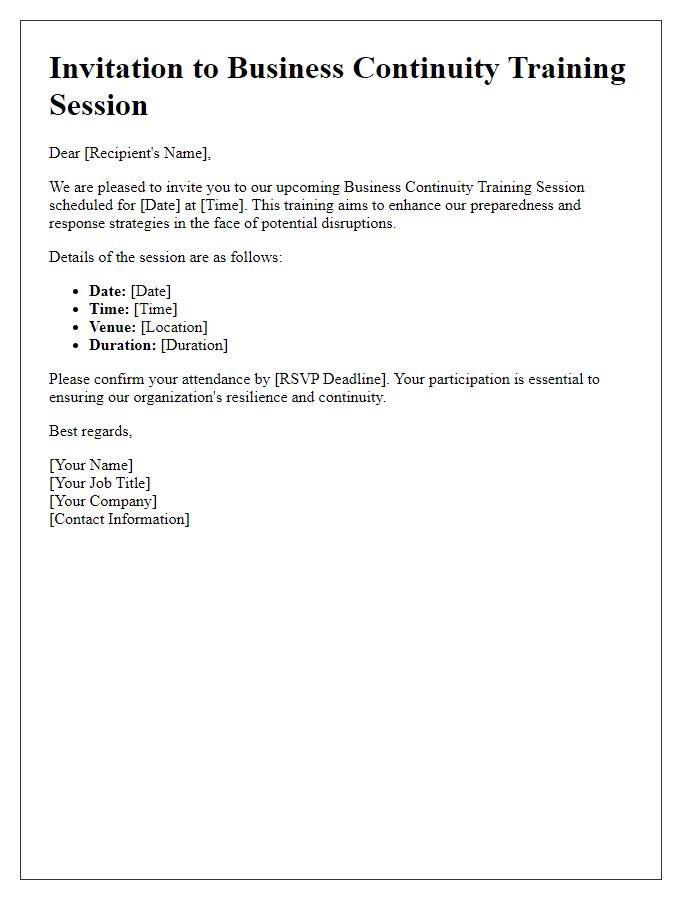In the ever-evolving landscape of business, having a robust continuity plan is more crucial than ever. A well-crafted letter outlining your organization's business continuity strategy not only reassures stakeholders but also sets the stage for operational resilience. It serves as a roadmap, guiding your team through potential disruptions while ensuring that essential functions remain intact. Interested in learning how to create an effective letter for your business continuity planning? Read on!

Clear Objectives and Goals
Effective business continuity planning requires clearly defined objectives and goals that align with organizational priorities. Establishing specific objectives, such as maintaining essential operations during a disruption, can ensure minimal impact on service delivery. Goals should include key metrics, for instance, ensuring 95% operational uptime during incidents, and restoring critical functions within 24 hours. Identify critical business functions, such as customer service, supply chain management, and IT infrastructure, to prioritize recovery efforts. Furthermore, the plan should address potential risks, including natural disasters, cyber threats, and pandemics, ensuring that a comprehensive risk assessment is conducted annually. Regular training sessions and simulations can help ensure staff readiness, fostering a resilient organizational culture.
Risk Assessment and Management
A comprehensive risk assessment and management plan is crucial for business continuity, particularly in sectors susceptible to disruptions. This plan should involve identifying critical processes, such as supply chain logistics, that could be impacted by unforeseen events like natural disasters (e.g., hurricanes, earthquakes), pandemics (such as COVID-19), or cyberattacks on information technology systems (including ransomware). Each potential risk must be evaluated for its likelihood of occurrence and impact severity, using a quantitative scale from 1 to 5. Following this assessment, strategies for risk mitigation should be developed, incorporating both preventive measures and response protocols. Regular training sessions should be conducted to ensure employees are familiar with emergency procedures and communication channels, including the crisis management team's contact information. Additionally, periodic reviews of the risk assessment should take place to adapt to changing business environments and emerging threats, ensuring the organization remains resilient and prepared for any challenge.
Key Contact Information
In business continuity planning, establishing key contact information is crucial for effective communication and coordination during a crisis. Essential contacts include primary decision-makers, such as the Chief Executive Officer (CEO) and the Chief Operations Officer (COO), whose roles are critical in guiding the organization's response strategies. Additional contacts encompass the Human Resources Manager, responsible for employee-related issues, and the IT Director, who oversees technology recovery efforts. Including emergency service contacts, such as local police, fire department, and emergency medical services ensures prompt assistance. Moreover, listing third-party vendors, such as communication providers and logistics partners, facilitates uninterrupted operations. Regular updates to this contact list ensure accuracy and accessibility during stressful situations, enhancing the organization's resilience against disruptions.
Essential Resources and Assets
Business continuity planning (BCP) emphasizes the identification of essential resources and assets necessary for maintaining operations during disruptions. Critical assets include technology infrastructure, such as servers, data centers, and communication systems. Human resources, including key personnel and emergency response teams, play a vital role. Physical resources encompass facilities, equipment, and inventory, ensuring the capability to continue production or service delivery. Financial assets such as capital reserves, credit lines, and insurance coverage provide necessary funding during recovery phases. Documenting supplier relationships and transport logistics is crucial for securing uninterrupted resource flows. Recognizing these elements fosters resilience and preparedness against potential crises, like natural disasters or cyber-attacks, ensuring operational stability in volatile situations.
Communication and Crisis Management Strategies
Effective communication during a crisis is vital for business continuity planning. Clear communication protocols ensure that stakeholders, including employees, clients, and suppliers, are kept informed. For example, utilizing a multi-channel approach such as emails, text alerts, and social media updates caters to diverse preferences in information access. Establishing a command center at a location, such as headquarters or a designated safe space, allows for coordinated messaging efforts. Crisis management teams, comprising representatives from different departments like HR, IT, and public relations, should be trained to respond swiftly to incidents. Regular drills and simulations prepare staff for real-life emergencies, ensuring everyone knows their roles. Documenting communication plans within a business continuity plan (BCP) enhances readiness and resilience during unexpected events, facilitating an organized response.













Comments